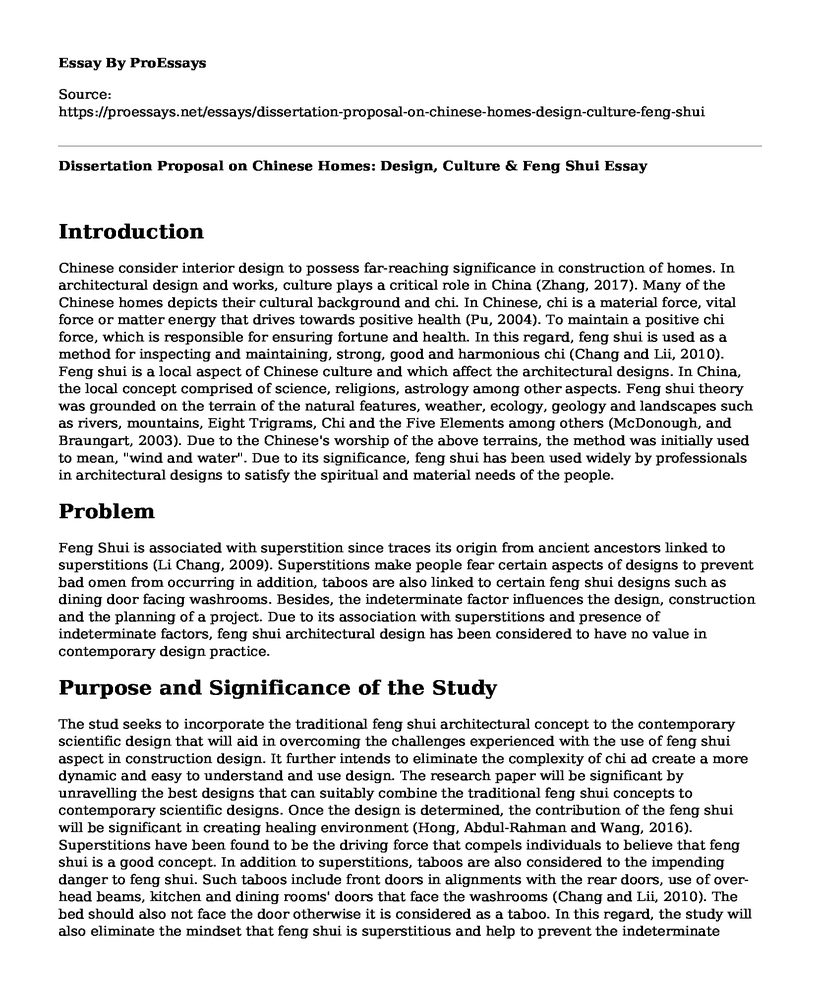Introduction
Chinese consider interior design to possess far-reaching significance in construction of homes. In architectural design and works, culture plays a critical role in China (Zhang, 2017). Many of the Chinese homes depicts their cultural background and chi. In Chinese, chi is a material force, vital force or matter energy that drives towards positive health (Pu, 2004). To maintain a positive chi force, which is responsible for ensuring fortune and health. In this regard, feng shui is used as a method for inspecting and maintaining, strong, good and harmonious chi (Chang and Lii, 2010). Feng shui is a local aspect of Chinese culture and which affect the architectural designs. In China, the local concept comprised of science, religions, astrology among other aspects. Feng shui theory was grounded on the terrain of the natural features, weather, ecology, geology and landscapes such as rivers, mountains, Eight Trigrams, Chi and the Five Elements among others (McDonough, and Braungart, 2003). Due to the Chinese's worship of the above terrains, the method was initially used to mean, "wind and water". Due to its significance, feng shui has been used widely by professionals in architectural designs to satisfy the spiritual and material needs of the people.
Problem
Feng Shui is associated with superstition since traces its origin from ancient ancestors linked to superstitions (Li Chang, 2009). Superstitions make people fear certain aspects of designs to prevent bad omen from occurring in addition, taboos are also linked to certain feng shui designs such as dining door facing washrooms. Besides, the indeterminate factor influences the design, construction and the planning of a project. Due to its association with superstitions and presence of indeterminate factors, feng shui architectural design has been considered to have no value in contemporary design practice.
Purpose and Significance of the Study
The stud seeks to incorporate the traditional feng shui architectural concept to the contemporary scientific design that will aid in overcoming the challenges experienced with the use of feng shui aspect in construction design. It further intends to eliminate the complexity of chi ad create a more dynamic and easy to understand and use design. The research paper will be significant by unravelling the best designs that can suitably combine the traditional feng shui concepts to contemporary scientific designs. Once the design is determined, the contribution of the feng shui will be significant in creating healing environment (Hong, Abdul-Rahman and Wang, 2016). Superstitions have been found to be the driving force that compels individuals to believe that feng shui is a good concept. In addition to superstitions, taboos are also considered to the impending danger to feng shui. Such taboos include front doors in alignments with the rear doors, use of over-head beams, kitchen and dining rooms' doors that face the washrooms (Chang and Lii, 2010). The bed should also not face the door otherwise it is considered as a taboo. In this regard, the study will also eliminate the mindset that feng shui is superstitious and help to prevent the indeterminate factors that affect the design negatively.
Research Questions
The following are the research questions that will guide this research paper:
- Can feng shui traditional architectural concept be integrated into contemporary design practice?
- Does Feng Shui have a connection to traditionally linked superstitions?
- Does Feng shui design create a healing environment?
Hypothesis
This is the hypothesis that this study aims to test through the methodology;
Feng shui can be integrated into contemporary scientific designs due to its invaluable benefits such as creation of healing environments.
References List
Chang, W. and Lii, P. (2010). Feng Shui And Its Role In Corporate Image And Reputation: A Review From Business And Cultural Perspectives. Journal of architectural and planning research, [online] 27(1), pp.1-14. Available at: https://www.researchgate.net/publication/298506096 [Accessed 12 Oct. 2019].
Hong, W., Abdul-Rahman, H. and Wang, C. (2016). The application of Form School Feng Shui model in a sleep environment: human preferences and subjective sleep quality evaluation. Architectural Engineering and Design Management, 12(6), pp.442-459.
Li Chang, W. (2009). Using Feng Shui to Create a Positive Corporate Reputation. Corporate Reputation Review, 12(1), pp.43-51.
McDonough, W. & Braungart, M. (2003). The Hannover Principles: Design for Sustainability, Green@work magazine (May/June 2003), FL: Green at Work Inc.
Pu, G. (2004). A Translation of the Ancient Chinese: The Book of Burial (Zang Shu), New York: The Edwin Mellen Press, Ltd.
Zhang, S. (2017). The heritage practices in a Chinese historic neighbourhood: the manifestation of traditional Feng Shui in Langzhong, China. International Journal of Heritage Studies, 24(5), pp.531-546.
Cite this page
Dissertation Proposal on Chinese Homes: Design, Culture & Feng Shui. (2023, Feb 27). Retrieved from https://proessays.net/essays/dissertation-proposal-on-chinese-homes-design-culture-feng-shui
If you are the original author of this essay and no longer wish to have it published on the ProEssays website, please click below to request its removal:
- Family Encouragements and Academic Achievements Personal Essay
- Critical Summary for "Fathers Are Parents, Too!" Paper Example
- A Travel Guide of a Fictional Horror Night Event Paper Example
- New World A-Coming: Black Religion and Racial Identity During the Great Migration by Dr. Judith Weisenfeld
- Haru in the Garden
- Paper Example on My Family Values vs. Cultural/Ethnic Values
- Culture Differences Affect Marketing - Essay Sample







